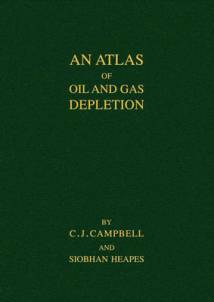Geoscientist 19.10 October 2009
An Atlas of Oil and Gas Depletion
Colin J Campbell & Siobhan Heapes
Published by: Jeremy Mills Publishing
Publication date: August 2008
ISBN: 978-1906600-26-6
List price: £110.00
396 pp
www.jeremymillspublishing.co.uk

The world is dependent on oil and gas – currently supplying 50% of total energy needs - so assessing resources and predicting future production are immensely important. No one has probably devoted more effort to this than Colin Campbell. This is his fifth book since 1991, and in 2002 he founded ‘The Association for the Study of Peak Oil and Gas’ (www.aspo-ireland.org). He has two aims: to highlight the importance of ‘peak oil’ and to predict when peak oil and peak gas production may occur.
The bulk of this book comprises chapters on 63 countries each with standardised contents: a table of past and future production and dates for peak discovery and production; graphs of discovery, production and depletion from 1930 to 2007; analyses of past discovery trends to predict ultimate recoverable resources and predicted production to 2030; notes on geology, discovery, production, consumption and history. The new method for predicting future discovery involves a spreadsheet with the above data and eight steps. The critical step utilises graphs showing the discovery trend and the derivative logistic (annual/cumulative vs cumulative production) extrapolated to zero, to give the total produced when production ends; the authors adjust this value based on exploration maturity.
Seven regional sections outline statistics on a further 93 ‘minor’ countries. Concluding chapters summarise the findings for ‘regular, conventional oil and gas’ in the world, briefly review non-conventional oil and gas, set the oil age in perspective and give 900 references on petroleum resources. The book’s conclusions are these: about 50 countries have already passed ‘peak oil’; the most important that have not are in the Middle East–Caspian region; the world ‘peak’ for oil was 2005; two thirds of the countries analysed have not reached ‘peak gas’; the world ‘peak’ for gas will be 2021.
Should we believe these predictions? There are numerous difficulties - predicting from past results cannot reveal new basins / petroleum systems / plays / ideas; excluding polar and deep-water (>500m) finds seems unnecessary; scant attention is given to improved-oil-recovery etc. Nevertheless, this book is the best yet and deserves to be known to all concerned with the geoscience of petroleum resources. I will let the author have the final word: “it is recognised that the page numbers are probably the only accurate ones, such is the state of confusion on public data, but, that said, the general patterns of depletion can be put forward with confidence.”
Anthony Spencer